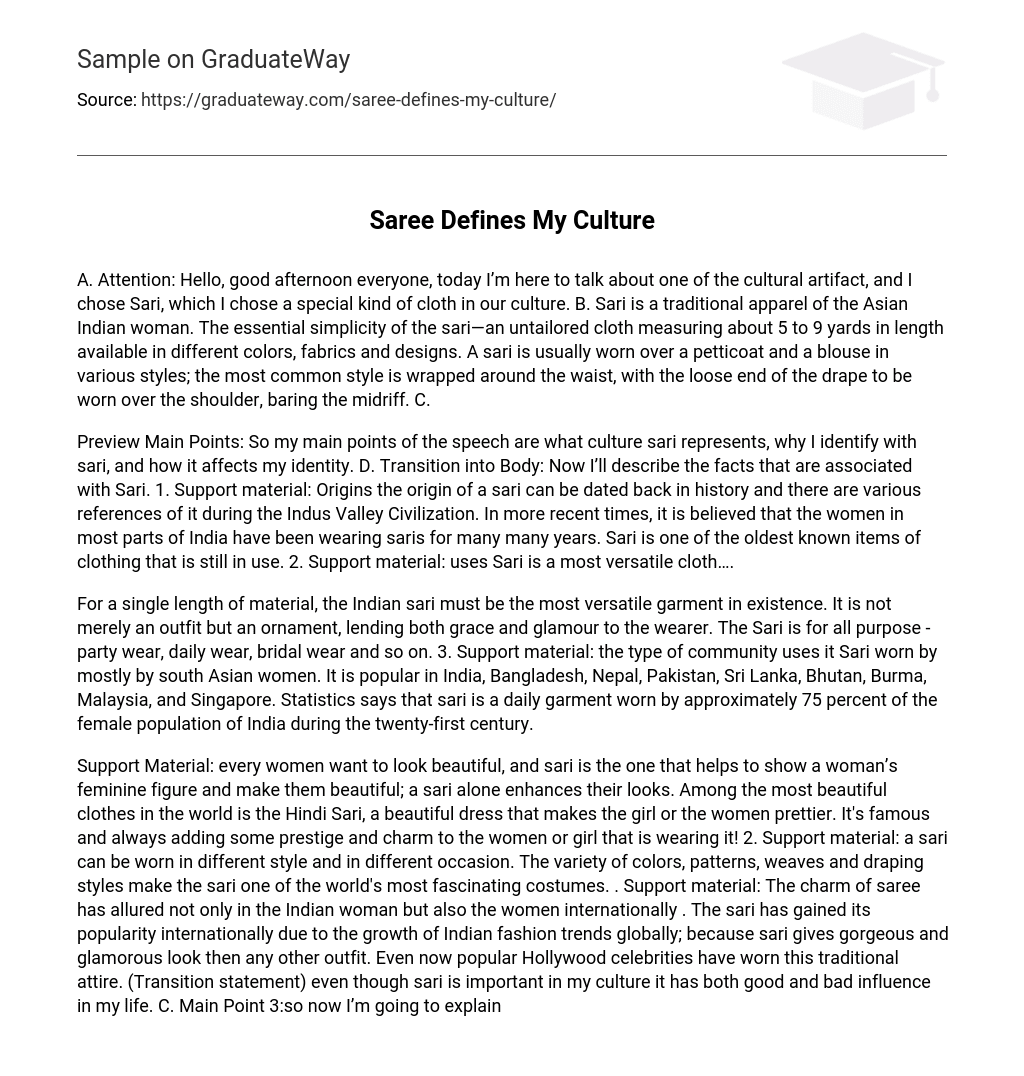A. Attention: Hello, good afternoon everyone, today I’m here to talk about one of the cultural artifact, and I chose Sari, which I chose a special kind of cloth in our culture. B. Sari is a traditional apparel of the Asian Indian woman. The essential simplicity of the sari—an untailored cloth measuring about 5 to 9 yards in length available in different colors, fabrics and designs. A sari is usually worn over a petticoat and a blouse in various styles; the most common style is wrapped around the waist, with the loose end of the drape to be worn over the shoulder, baring the midriff. C.
Preview Main Points: So my main points of the speech are what culture sari represents, why I identify with sari, and how it affects my identity. D. Transition into Body: Now I’ll describe the facts that are associated with Sari. 1. Support material: Origins the origin of a sari can be dated back in history and there are various references of it during the Indus Valley Civilization. In more recent times, it is believed that the women in most parts of India have been wearing saris for many many years. Sari is one of the oldest known items of clothing that is still in use. 2. Support material: uses Sari is a most versatile cloth….
For a single length of material, the Indian sari must be the most versatile garment in existence. It is not merely an outfit but an ornament, lending both grace and glamour to the wearer. The Sari is for all purpose – party wear, daily wear, bridal wear and so on. 3. Support material: the type of community uses it Sari worn by mostly by south Asian women. It is popular in India, Bangladesh, Nepal, Pakistan, Sri Lanka, Bhutan, Burma, Malaysia, and Singapore. Statistics says that sari is a daily garment worn by approximately 75 percent of the female population of India during the twenty-first century.
Support Material: every women want to look beautiful, and sari is the one that helps to show a woman’s feminine figure and make them beautiful; a sari alone enhances their looks. Among the most beautiful clothes in the world is the Hindi Sari, a beautiful dress that makes the girl or the women prettier. It’s famous and always adding some prestige and charm to the women or girl that is wearing it! 2. Support material: a sari can be worn in different style and in different occasion. The variety of colors, patterns, weaves and draping styles make the sari one of the world’s most fascinating costumes. . Support material: The charm of saree has allured not only in the Indian woman but also the women internationally . The sari has gained its popularity internationally due to the growth of Indian fashion trends globally; because sari gives gorgeous and glamorous look then any other outfit. Even now popular Hollywood celebrities have worn this traditional attire. (Transition statement) even though sari is important in my culture it has both good and bad influence in my life. C. Main Point 3:so now I’m going to explain how sari affects my identity 1.
Supporting Material: I have seen my mom, my grandma and all the older women and even some of my cousins wearing sari all the time. 2. Supporting Material: I have lots of saries that I got from my relatives and friends as a gift and Most of the occasion I wear sari. a sari is the versatile cloth in the world; it can be preserved for long time. I have my moms wedding sari when I got married. 3. Supporting Material: bad influence like sometimes somebody give me different look, I feel like discriminated and every time I wear sari it takes long time but mom takes less time.





